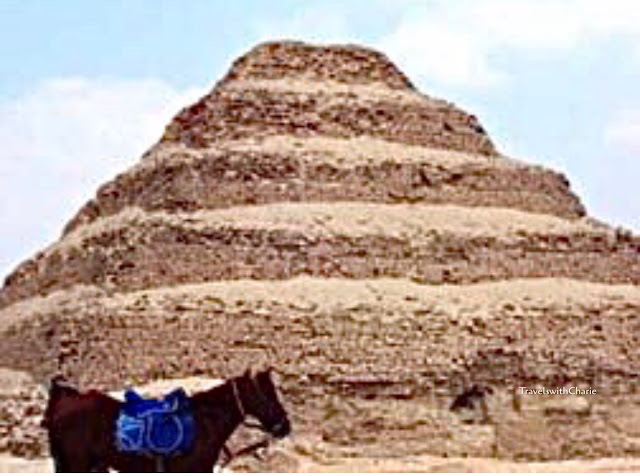Racing out of Cairo toward Giza, I caught a glimpse of the pyramids in the distant horizon. I saw hazy outlines because the Egyptian sky goddess, Nut, had swallowed all but a tiny slice of the sun and the sheer veil of twilight had draped the countryside.
Looking out the window, I was surprised to see the looming pyramid of Kufhu (Cheops). It would take another week before I could view these vestiges of the Old Kingdom up close and explore them intimately.
For several days we drifted leisurely on the Nile, from Luxor to Aswan, and marveled at the temples and tombs of the kings. Every morning I woke up to a spectacular sunrise and the promise of new discoveries. Our guide would take us to a historical site early in the day and there he would nourish us with interesting vignettes of pharaonic civilization. The evenings were devoted to sampling Egyptian cuisine and colorful local entertainment.
The unhurried and gentle life on the Nile with tremendous views of green riverbanks bordered by sand and rock was in sharp contrast to the traffic, noise and crowds that greeted us in Cairo. From the Citadel above the city, the Cairo metropolis spreads out to yonder suburbs under a threatening cloud of smog.
In the adjacent Alabaster Mosque, with its twin slender minarets, Muhammad Ali lies in repose. Ali and his successors were responsible for centralizing the government, strengthening the army, building new infrastructure and reviving the economy. Ali is considered the founder of Modern Egypt.
Christianity found its way to Misr (the Arabic name of Egypt) just as the Holy Family did shortly after Jesus was born. When Mary and Joseph fled to Egypt with the baby Jesus, it is believed they stayed in what is today the Church of St. Sargius in the walled Coptic quarter of Cairo. Herod, the Roman king in Judea then, feared for his throne when the Magi informed him that they were on their way to see “He who is born the King of the Jews”. So he ordered the murder of all male children under the age of two in Bethlehem and the surrounding areas to eliminate once and for all the threat he perceived. And he failed!
In the outskirts of Cairo on the Giza plateau, the necropolis of the Old Kingdom rulers is feeling the pinch of encroaching suburbia. While the pyramids of Khufu, Khafre and Menkaure dominate the landscape, there are a trio of smaller pyramids built for the queens and several mastabas (mounds) which are the forerunners of the pyramids.
From the simple rectangular mound arose the earliest pyramidal form, the step pyramid. In Sakkara, just minutes from Giza, the step pyramid of Djoser (Zoser) was built around 2659 BC by his architect, Imhotep. Five mastabas were stacked one on top of the other, each one smaller than its base, creating a step profile. In succeeding years, the pyramid would take on a smoother outline and evolve into the “true” pyramidal shape we recognize today.
To explore the interior of a pyramid, a “false” door leading into a chamber inside Khafre’s pyramid is accessible to visitors. I walked in a stooped position inside a narrow, poorly lit corridor that seemed to climb up interminably. At the end of the passage is a plain room with a tomb. It was clearly not Khafre’s burial chamber but one built to fool early tomb raiders. What an experience it turned out to be but it is not for the claustrophobic!
Perhaps the most intriguing monument in Giza is that of the Great Sphinx. As a child, I had heard the riddle of the Sphinx several times. It asks, “What creature goes on four legs in the morning, two legs at noon, and upon three legs in the evening?” According to Greek mythology, giving the answer “man” would have made the responder king. But an incorrect reply would have resulted in the strangulation of the hapless victim. The archaic word for to strangle is sphingo, from which Sphinx is derived.
There are mysteries surrounding its age, identity and purpose. While it is commonly believed that the face of the Sphinx is that of Khafre (Chephren), the builder of the middle pyramid, other research suggests the image may be that of his brother, Djedefre. There is yet another study that hints the Sphinx may predate the construction of the great pyramids.
Thutmosis IV (1400-1390BC) claimed the Sphinx appeared to him in a dream asking him to clear the sand engulfing it. For this he would be rewarded well. And so he removed the sand that wrapped the Sphinx up to its neck. And the former prince became king.
Before leaving Egypt I had my own sand clearing to do. Getting rid of fine, loose grains from what used to be a pair of black leather shoes was quite a chore because sand was lodged in all the nooks and crannies of my Easy Spirit loafers, There were no great rewards for this effort but it made me appreciate why the Sphinx wanted to free itself from the ubiquitous sand. Imagine being buried under sand and never see the rising sun again!
Tour information: Trafalgar Tours offers several tours to Egypt that include a Nile cruise and visits to all the sites mentioned in this article. They also have tours to Abu Simbel and Alexandria. Their website is www.trafalgar.com or Auto Association members may contact the travel department at www.csaa.com.
This article appeared in the Manila Bulletin issue of May 12-18, 2005.
*****
Image by TravelswithCharie



